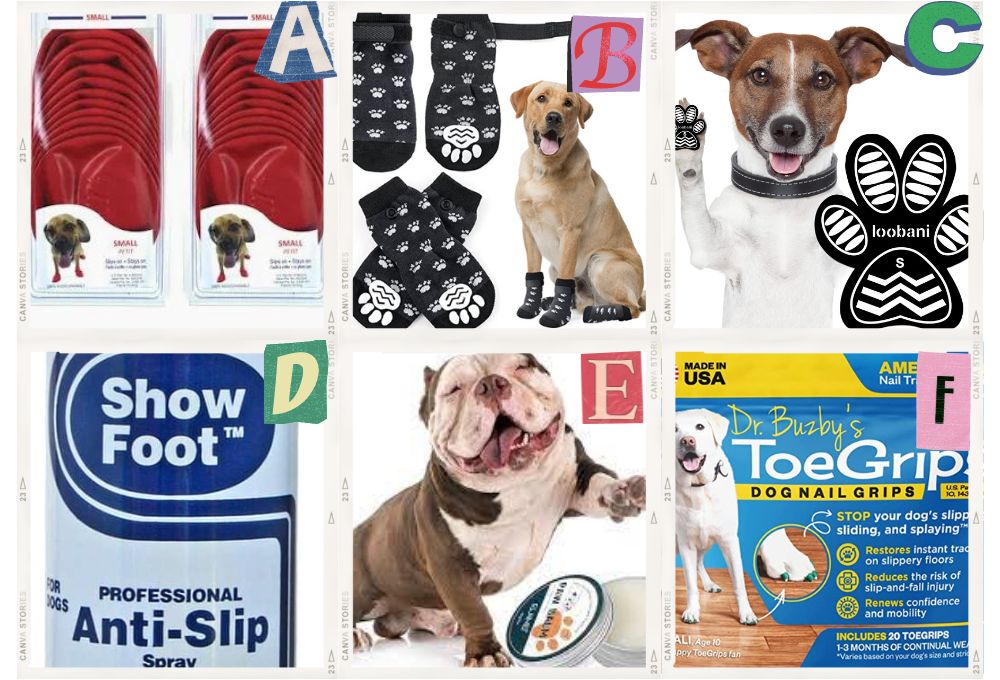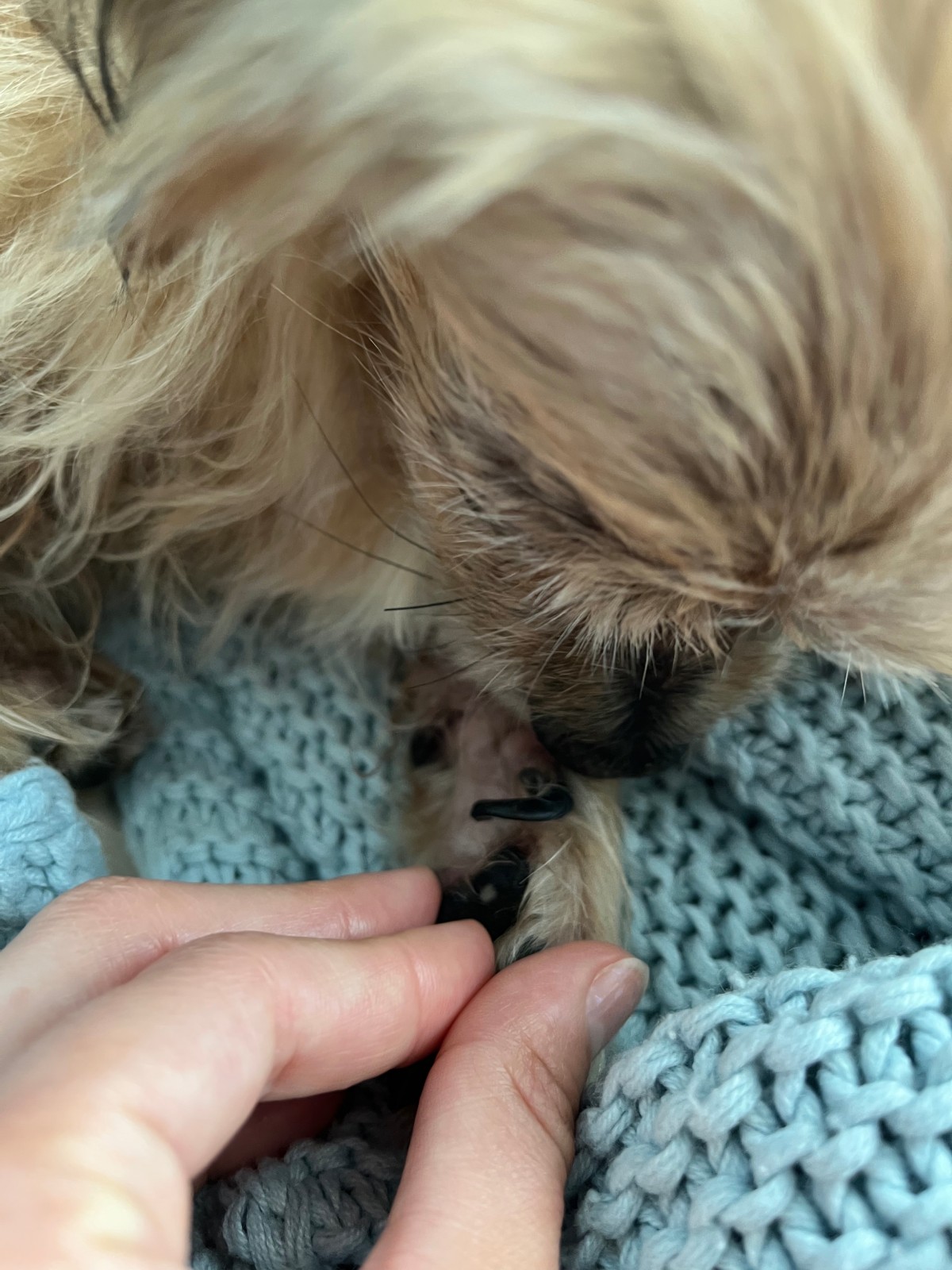
Senior dogs may slip on floors for several reasons including arthritis, muscle weakness, vision impairments, and cognitive decline. Your role as their loving parent is to make them feel protected and safe, just like when they were puppies, and implement preventative measures to avoid serious injuries. You can use mats or carpets, make them wear paw gripping or rubber boots, trim their nails regularly, maintain the floors clean and dry, adapt your home with mobility aids, and consider physical therapy.
In this article, we will review these preventative measures and ensure our beloved senior dogs can navigate their surroundings with ease and comfort.
Why do senior dogs slip on floors?
Here are some key factors that contribute to senior dogs slipping on floors:
- Decreased traction: Check if your pup’s paws are dry. This typically can result in reduced traction and an increased risk of slipping.
- Muscle weakness: It is common among older dogs, particularly in their hind legs. This can make it challenging for them to maintain stability and balance on slippery floors.
- Joint issues: Conditions like arthritis are common among senior dogs, affecting their joints and causing discomfort. Pain or stiffness in the joints can make it difficult for them to move confidently on slippery surfaces.
- Vision and cognitive changes: Vision problems make it harder for them to judge distances and perceive potential hazards, and cognitive changes may affect their response to slippery surfaces.
The Dangers of Slipping for Senior Dogs
- Injuries: Old dogs are more susceptible to injuries like sprains, strains, muscle pulls, and even fractures, due to their reduced bone density and weaker musculoskeletal structure.
- Loss of confidence: Frequent slipping incidents can significantly impact a senior dog’s confidence and willingness to move around the house. This can lead to decreased physical activity, which can further contribute to muscle weakness and joint stiffness.
- Aggravation of existing conditions: Dogs with pre-existing joint conditions, such as hip dysplasia or arthritis, may experience increased pain and discomfort when they slip on floors. Slips can worsen their condition and reduce their overall quality of life.
Creating a Safe Home Environment for Senior Dogs
We can make a few simple modifications to our homes to significantly reduce the risk of slipping incidents and provide our furry friends with a secure environment.
1. Provide Adequate Traction
- Area rugs and carpets: You can place them in areas where your dog spends the most time, such as hallways, living rooms, and near their bed. These rugs provide grip and stability, minimizing the risk of slipping.
- Non-slip mats: Utilize non-slip mats or adhesive strips in areas prone to water or spills, such as the kitchen or bathrooms.
2. Paw Grips for Senior Dogs
Paw pad protection will provide your senior dog with additional traction on slippery surfaces. Here are a couple of examples, but there are many more options available. You may need to try some options before realizing what works best for your dog.
- Rubber boots (A)
- Anti-slip pet socks (B)
- Traction pads (C)
- Dog paw anti-slip spray (D)
- Paw balm (E)
- Toe grips (F)

3. Keep Nails Trimmed
Long nails can hinder a dog’s grip on smooth surfaces, increasing the likelihood of slipping. Try to do it regularly and make it a pleasant experience for them.

4. Provide Supportive Footwear
In some cases, senior dogs may benefit from wearing specialized footwear designed to improve traction and stability. Dog booties with rubber soles can provide additional grip and prevent slipping accidents. Introduce the footwear gradually and ensure it fits comfortably without causing any discomfort or restricting circulation.
5. Maintain a Clean and Dry Environment
- Clean up spills immediately and use absorbent materials like paper towels or a mop to remove moisture effectively.
- Regularly sweep and mop: Keep floors free from debris, dust, and hair by sweeping and mopping regularly. This helps maintain a clean surface with better traction.
- Use pet-friendly cleaning products: Avoid using harsh chemicals or cleaning products that leave a slippery residue. Opt for pet-friendly alternatives that prioritize safety without compromising cleanliness.
6. Consider Gentle Exercise and Physical Therapy
Engage in gentle exercises, such as short walks or swimming, to help improve their overall strength and balance. You should also consult with a veterinarian or a professional animal physical therapist to explore tailored exercises or therapy options that can address your senior dog’s specific needs.
7. Modify the Environment
- Install ramps or stairs in areas where your dog frequently encounters elevation changes, such as near beds or sofas. This provides them with a safer alternative to jumping or climbing, reducing the risk of slips and falls.
- Use pet gates to limit access to areas with slippery surfaces, such as stairs or rooms with hardwood floors. This ensures your senior dog avoids potentially hazardous areas.
What is the best non-slip flooring for dogs?
If you happen to be buying new floors for your home, it would be a good idea to explore some of the best-friendly options. Here are some examples:
- Vinyl plank flooring is the most slip resistant and soft
- Laminate
- Bamboo
Final Thoughts
Maintain a safe environment for your senior dog to prevent slipping accidents and promote their overall well-being. It is equally important to be there to help them build back their confidence when they fall.
Remember, regular veterinary check-ups and consultations are essential to address any underlying health concerns and obtain professional guidance tailored to your senior dog’s specific needs.
FAQs
Some dog breeds have a higher predisposition to slipping accidents due to their anatomy or genetics. Breeds with short legs, such as Dachshunds or Basset Hounds, may have a more challenging time maintaining stability on smooth surfaces. However, it’s essential to note that senior dogs of any breed can experience slipping issues, especially as they age.
Yes, senior dogs can regain their confidence with patience, support, and a safe environment. By implementing the preventive measures discussed in this guide and providing positive reinforcement, you can help your furry friend rebuild their confidence and navigate their surroundings with increased assurance.
While it’s crucial to minimize the risk of slipping accidents, it’s equally important to ensure your senior dog remains physically active. Restricting their movement excessively can lead to muscle atrophy, joint stiffness, and other health issues. Focus on creating a safe environment using the tips mentioned earlier, allowing your senior dog to move comfortably and engage in appropriate physical activity.
Occasional slipping can happen, even with preventive measures in place. However, if your senior dog is experiencing frequent or severe slipping incidents, it’s advisable to consult with a veterinarian. They can assess any underlying health conditions or provide further guidance specific to your dog’s needs.
Yes, several joint supplements can support your senior dog’s joint health and mobility. Glucosamine, chondroitin sulfate, and omega-3 fatty acids are common ingredients found in joint supplements for dogs. Consult with your veterinarian to determine the most suitable supplements and dosage for your senior dog.
If your senior dog continues to struggle with slipping on floors despite implementing preventive measures, it’s essential to seek professional help. Consult with a veterinarian or a certified animal physical therapist who can evaluate your dog’s condition and provide tailored recommendations or therapies to address their specific needs.
Recommended reads
- Is the Dogo App Worth It? Honest Review After Training My Dog
- Amazon’s Top Black Friday and Cyber Monday Deals for 2024: Dog Products Edition
- Top Pet Trackers for Sending Your Dog with a Pet Sitter
- Should Dogs Wear Bells?
- Which Dog Breed Has the Longest Lifespan?
Recent Posts
Is the Dogo App Worth It? Honest Review After Training My Dog
Training your dog shouldn’t feel like another chore, but it often does because, unless you’re a professional trainer, you have to research everything yourself first. And that research can take...
Amazon's Top Black Friday and Cyber Monday Deals for 2024: Dog Products Edition
The holiday shopping season has officially started and Amazon has already released some incredible deals on pet products for Black Friday and Cyber Monday 2024. Here is our curated list of the...
